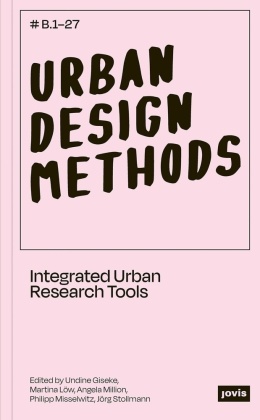| Verlag | Jovis |
| Auflage | 2020 |
| Seiten | 256 |
| Format | 13,4 x 2,9 x 21,1 cm |
| Gewicht | 446 g |
| Artikeltyp | Englisches Buch |
| ISBN-10 | 3868595716 |
| EAN | 9783868595710 |
| Bestell-Nr | 86859571A |
Urban Design Methods ist ein Handbuch, das zeitgenössische Herangehensweisen an die immer komplexer werdenden Anforderungen bei der Gestaltung urbaner Lebensräume vermittelt. Oft erfahren Architekt_innen, Landschaftsarchitekt_innen, Stadt-, Regional- und Landschaftsplaner_innen, dass sie heutigen Aufgaben mit ihren fachspezifischen Kenntnissen nicht wirklich gerecht werden können. Die Komplexität der Fragestellungen und die wachsende Zahl der betroffenen und zu beteiligenden Akteure erfordert kooperative Ansätze. Urban Design, verstanden als ein inter- und transdisziplinäres Tätigkeitsgebiet im Schnittfeld von Architektur, Stadt- und Regionalplanung, Landschaftsarchitektur, Soziologie und vielfältigen lebensweltlichen Akteuren, braucht ein Kompendium poröser Methoden, mit deren Hilfe die Grenzen zwischen Theorie und Praxis, zwischen natürlichen und sozialen Systemen aufgelöst werden. Dieses Buch versammelt erstmals ein weites Spektrum von Methoden, die Urban Designer dabei unterst ützen sollen, den Kontext, in dem sie arbeiten, zu dechiffrieren und ein individuelles Berufsverständnis zu finden. Es umreißt anschaulich die Bandbreite der Herausforderungen und die beständig neu zu definierenden Handlungsfelder.
Urban Design Methods is a manual for reconciling contemporary approaches with increasingly complex demands in the shaping of urban living spaces. Architects and landscape architects, as well as city, regional, and landscape planners, often find that they are unable to do modern projects justice with their specialist skills alone. Cooperative approaches are needed to deal with both the complexity of raising questions and the growing number of affected parties who need to be involved. Urban design-understood as an inter- and transdisciplinary field at the interface of architecture, city and regional planning, landscape architecture, sociology, and the diverse stakeholders involved in any project-requires a compendium of adaptable methods to dissolve the boundaries between theory and praxis and between natural and social systems. For the first time, this book collects a broad spectrum of methods intended to support urban designers in deciphering the contexts in which they work, and h elp them attain a greater individual professional understanding. It clearly outlines the range of challenges and the constantly evolving areas of activity.
Rezension:
"[...] the book is a pleasure to dip into to gain a rapid understanding of the approaches, particularly for those seeking to move beyond their comfort zone and try something new. The book is a place to start and a source of inspiration." (Matthew Carmona in Urban Design)

